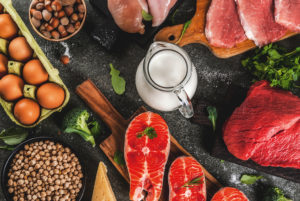
Protein is key to your well-being and deserves a significant place in every diet. Knowing the best sources can boost your health as well as help you feel more satisfied on fewer calories.
Seafood is an excellent protein source, with dozens of types of fish and shellfish to try. Eat a 3.5-ounce serving at least twice every week, and include fish high in omega-3 fatty acids, such as salmon and trout. These are nutrients that your body needs, but can’t make, so you must get them through your diet.
Our Take
As a registered dietitian at Spectrum Health Blodgett Hospital, Gregory Stacey recommends eating no more than one or two servings of meat per day, which is about 3 oz. or the size of a deck of cards.
“Chicken, fish, pork, beef, they all have about 20 grams of protein,” he said. “And all the protein from all the other foods adds up.”
“Also, eggs have about 6 grams of protein per day, but the more eggs you eat, the more cholesterol you’ll be taking in. If you’re going to eat eggs, do a swap with meat, just to make sure your cholesterol and saturated fats stay low.”
Also, soy products–tofu, tempeh–provide a lot of protein. For vegetarians, they’re a good substitute for meat, and for non-vegetarians, “a good way to add new foods and provide health benefits you haven’t been getting before,” Stacey said.
Lastly, avoid processed meats like bacon, ham, jerky and hot dogs–they have been linked to cancer.
With exercise and proper eating habits, “you should start seeing noticeable changes in your body within the first month,” Stacey said.
Make friends with the manager of the seafood section at your favorite market and don’t be shy about asking for the freshest choices. Note: It’s usually seafood that’s past its prime that’s guilty of smelling up your kitchen, not fresh fish.
Chicken and turkey are other well-known protein sources, but you may not realize that it’s OK to cook them with the skin on to keep the meat moist. Just remove it before eating. Also, keep in mind that breast meat has less fat and therefore fewer calories than dark meat.
Be sure to put vegetable proteins on the menu. These include legumes such as beans and lentils. They have a protein-fiber combo that helps regulate blood sugar as well as fill you up.
What about red meat? For many people, it’s fine to eat it once a week or so. But choose lean cuts—skip the cold cuts, hot dogs and other cured meats—and limit the portion size to three ounces.
Trim off as much fat as you can before cooking, and pour off any melted fat before eating. Also use healthier cooking methods, such as baking, broiling and grilling on a rack, which allow fat to drain off.
 /a>
/a>
 /a>
/a>
 /a>
/a>